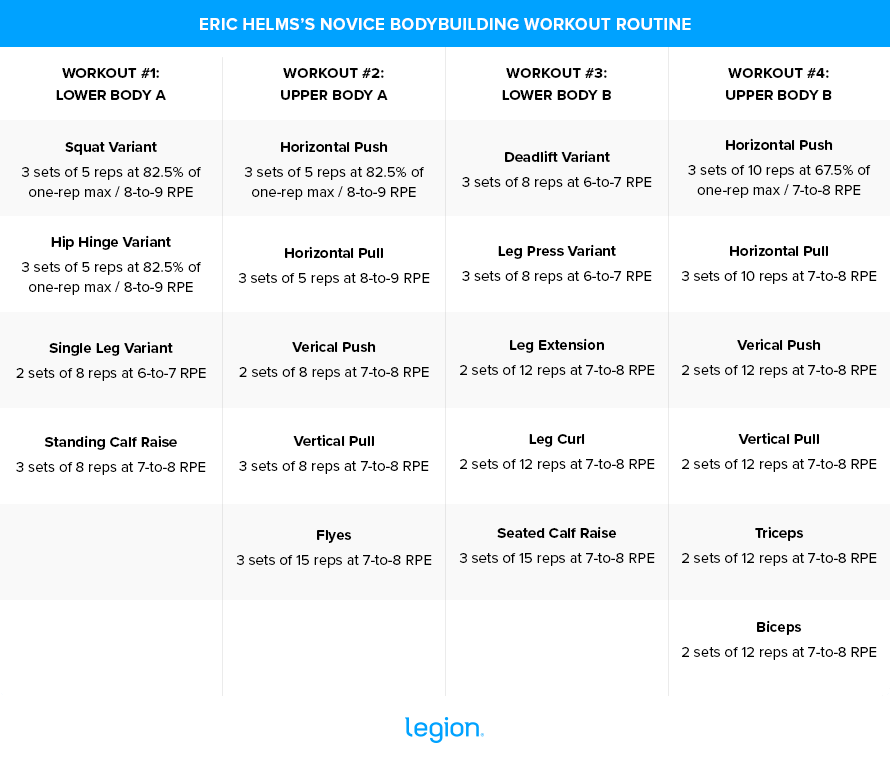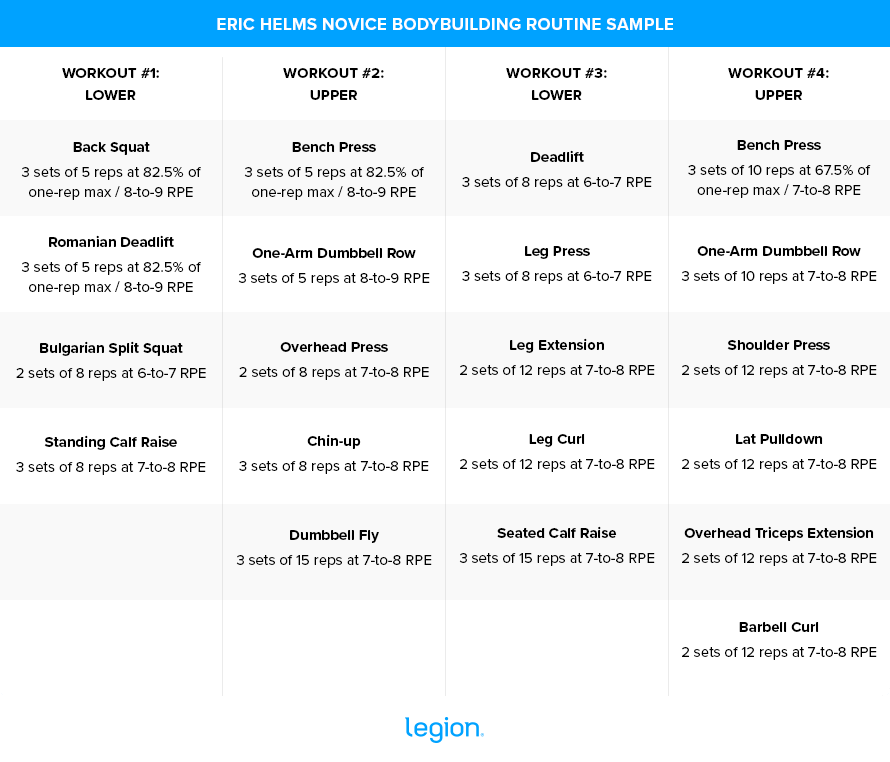Eric Helms’s Novice Bodybuilding Program is a strength training routine for new weightlifters looking to build muscle and get strong.
It’s one of the programs by Eric Helms, Andy Morgan, and Andrea Valdez featured in The Muscle & Strength Pyramids Training book, and it’s an excellent evidence-based program for anyone who has never followed a structured strength training program before.
In this article, you’ll learn what the Eric Helms Novice Bodybuilding Program is, how to schedule your workouts on the plan, which exercises it includes, how to progress, and more.
What Is The Eric Helms Novice Bodybuilding Program?
The Novice Bodybuilding Program is a 4-day strength training program that features in The Muscle & Strength Pyramids Training book, written by Dr. Eric Helms, Ph.D., Andrea Valdez, and Andy Morgan.
It’s for people new to strength training or who’ve never followed a structured strength training program but want to gain muscle and strength. Although it’s technically a “bodybuilding” program, you do enough sets in the 5-to-8-rep range to significantly increase your strength.
Structurally, it’s similar to the classic upper lower routine. What makes it slightly different, however, is it gives you numerical guidelines for how hard each exercise should feel. These numbers are known as ratings of perceived exertion (RPE), and they represent how hard a set feels on a scale of 1-to-10.
The main benefit of this RPE-based system is that it’s a simple way to gauge how hard you should train on any given day: If a weight feels light, you can train hard; if it feels heavy, you can throttle back. Adjusting your training intensity using RPE isn’t usually an option with programs based on percentages of your 1-rep maximum.
Eric Helms’s Novice Bodybuilding Program Overview
Schedule
The Eric Helms Novice Bodybuilding Program workout routine involves 4 weekly workouts: 2 upper-body workouts and 2 lower-body workouts.
Training four days per week is ideal for those who want to do plenty of volume (sets) without training every day of the workweek.
You can plan your workout days however it suits you; just remember two key rules:
- Follow the workout order: Lower body, upper body, lower body, upper body. Don’t do both lower or upper body sessions back-to-back, and don’t mix them up randomly.
- Don’t train more than two days in a row. Taking a break after every two workouts helps your body recover, which is vital for making steady progress.
Here’s a solid way to schedule your workouts that’ll work well for most:
- Mon: Lower Body A
- Tues: Upper Body A
- Wed: Rest
- Thurs: Lower Body B
- Fri: Upper Body B
- Sat: Rest
- Sun: Rest
Exercises
The Eric Helms’s Novice Bodybuilding Program doesn’t tell you exactly what exercises to do. Instead, it tells you what kind of exercises to do.
This is a pro because not everyone can do the same exercises with good form, pain-free, and through a full range of motion, so you can tailor the workouts to your unique needs, limitations, and preferences.
It’s also a con because unless you have some experience lifting weights, you probably aren’t sure what exercises you should try.
Here’s the template the program provides:

Routine
As we’ve already seen, you can organize the program however you like within the framework provided.
If you aren’t sure where to start, though, here’s one way you could arrange the beginner bodybuilding program based on the recommendations in the book:

Rest
You can organize your rest periods in two ways depending on whether you use “straight sets” or “antagonist paired sets” (APS).
- Straight sets: “Straight sets” involve performing a set of an exercise, resting, doing another set of that exercise, and repeating until you’ve finished all of your sets for that exercise. You repeat the same process with the other exercises in your workout until you’re finished.
If you decide to use straight sets, the program recommends resting as long as it takes to feel ready to give your all in your next set. As a general rule, this should be at least 1.5 minutes between smaller isolation exercises and 2.5 minutes between big compound exercises.
- APS: In this program, APS involve alternating between two exercises that train different muscle groups and resting between each exercise. If you use APS, rest around 2 minutes between each set of compound exercises and roughly 1 minute between each set of isolation exercises.
For example, in Workout #2, you could do a set of bench press, rest for 2 minutes, a set of one-arm dumbbell rows, rest another 2 minutes, and then repeat this process until you’ve completed all your sets for both exercises. Afterward, you’d switch to alternating between sets of the overhead press and chin-up.
Using APS is beneficial because it saves you time without hurting your performance. In fact, it may even improve your performance on some exercises.
There’s one caveat: don’t use APS for full-body exercises like squats, deadlifts, and lunges because they rely on so many muscle groups that doing almost any other exercise between sets will likely interfere with your strength.
Progression
Here’s everything you need to know about progressing on the Novice Bodybuilding Program:
- Try to increase the weight you lift on every exercise in every workout.
- Only increase the weight to the point that your last set of an exercise is no more than 1 RPE higher than the first. For example, let’s say you add 5 pounds to your squat from last week. If your first set feels like 8 RPE, your last set should feel no harder than 9 RPE.
- Increase the weights for each workout independently. That is, if you add 5 pounds to your bench press in Workout #2, you don’t necessarily add 5 pounds to your bench press in Workout #4. This ensures you stay within the right RPE range.
- If you can’t complete your planned number of reps for an exercise, use the same weight for that exercise next week.
- If you can’t complete your planned number of reps again, reduce the load by 10% and complete the same sets and reps. The next time you do that workout, try to hit your target reps with the weight you tried to use previously.










